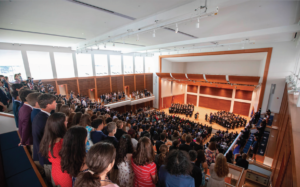
The School announced the 2049-2050 school year figures for racial and ethnic diversity. Photo courtesy of Choate Flickr
This article was released as part of a special issue that envisions the world in 2050. All content should be treated as fictional.
On Monday, February 21, 2050, Dean of Faculty Mr. Brian Moore made an announcement to the School that this year more than half of the Choate community, both students and faculty, identifies as a person of color. This increase in racial diversity on campus marks an important milestone for the School in its goal to create a more inclusive community.
According to a survey conducted in October 2049 by the Office of Institutional Research, of the 1,187 students and faculty on campus, 38% of faculty and 66% of students identify as a person of color or international. The rest either identify as white or declined to respond. These numbers are in large contrast to those reported 32 years ago, in 2018, when 20% of faculty and 55% of students identified as a person of color or from a country other than the United States.
Director of Equity and Inclusion Ms. Emily Hornsted said, “This is a milestone for the School. Back when the Pathways Program was founded, in the early 2000s, white students and faculty still made up the majority of our community. Since then, we’ve been slowly working toward building a more racially diverse community.”
Many faculty on campus, both those who have worked at Choate for many decades and those who have only been here for a few years, find the School’s increasing racial diversity inspiring. Science teacher Ms. Helen Padhanapan, now in her 20th year at Choate, recalled, “I’m impressed at how much diversity we have. When I first came, we had very few faculty who identified as Asian. Many of my senior advisees have expressed that they have felt more represented in the faculty over their years here.”
Ms. Hornsted emphasized the importance of the greater diversity on campus, saying, “I think it’s so important to have a diverse community so that the teaching and learning we do can be framed in that context of understanding. The students can be exposed to many cultures, backgrounds, and experiences, whether through interactions with their peers or faculty — and they can gain greater empathy for people who are different than they are.”
Research has shown that it is important for students to have teachers with whom they share common identifiers. According to a study conducted at American University, when black children were taught by black teachers between third and fifth grade, the boys were significantly less likely to drop out of high school, and both girls and boys were more likely to go on to attend college. Researchers suggest that students are more inspired by role models they can relate to and that teachers with similar identifiers are able to present material in a more culturally relevant way. By hiring more faculty of color, Choate hopes to elevate students’ experiences in the classroom and across campus.
Still, students and faculty alike do not think these statistics signify wholesale victory. Ms. Hornsted said, “Choate has seen a great improvement in diversity on campus, but in some ways those are only numbers. In conjunction with increasing diversity on campus, we also need to continue to focus on inclusion. We’ve taken a great step in bringing students and faculty of a variety of racial identities into the School, but we need to do everything we can to ensure that they feel welcome here.”
Over the years, Choate has been actively supporting students of all racial identities throughout their journey at the School. Faculty also engage in diversity and inclusion workshops regularly to ensure that their teaching practices are supportive of all students. However, the School still hopes to do more for inclusivity on campus. One ongoing initiative is the diversifying of curriculums; for instance, English teachers have been actively incorporating more authors of color into their class reading lists. Sophomore English teacher Mr. Dinesh Aggarwal said, “I always like to expose my students to a variety of writers because I believe it is an important aspect of learning literature. Authors of all racial identities have played major roles in writing and literature, and I think we need to always keep an eye on the potential for a whitewashing of our English curriculum.”
Despite how far the School has come in improving racial diversity on campus, Ms. Hornsted believes more can still be done. “Just because our community is much more racially diverse now than it once was doesn’t mean we shouldn’t continue to fight for equality,” she said.
She went on, “This also applies to communities outside of our own. Often, we are so wrapped up in Choate that we don’t realize we can take what we’ve learned here to reach out and help other communities. I hope our students will one day take this experience within this diverse community and make a difference elsewhere.”


